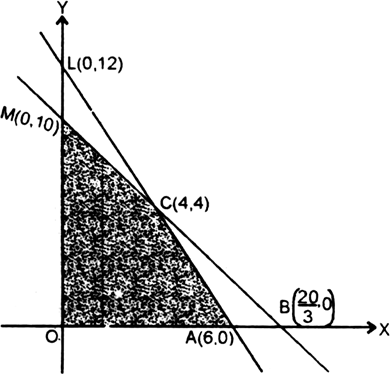 Long Answer Type
Long Answer TypeLet the manufacturer produce x pedestal lamps and y wooden shades everyday.
Let P be the profits
Table
|
Items |
Number |
Time on griding/cutting Machine (hours) |
Time on sprayer (hours) |
Profit (Rs.) |
|
Pedestal lamp |
A |
2x |
3x |
5x |
|
Wooden shade |
y |
y |
2y |
3y |
|
Total |
2x + y |
3x + 2y |
5x + 3y |
We are to maximise
P = 5x + 3y
subject to constraints
2x + y ≤ 12
3x + 2y ≤ 20
x ≥ 0, y ≥ 0
Consider a set of rectangular cartesian axes OXY in the plane.
It is clear that any point which satisfies x ≥ 0, y ≥ 0 lies in the first quadrant.
First, we draw the graph of 2x + y = 12
For x = 0, y = 12
For y = 0, 2 x = 12 or x = 6
∴ line meets OX in A(6, 0) and OY in L(0, 12).
Again we draw the graph of 3x + 2y = 20
For x = 0, 2y = 20 or y = 10
For y = 0, 3x = 20 or ![]()
![]() .
.
Since feasible region satisfies all the constraints.
∴ OACM is the feasible region.
The corner points are O(0, 0), A(6, 0), C(4, 4), M(0, 10)
At O(0, 0), P = 5 × 0 + 3 × 0 = 0 + 0 = 0
At A(6, 0), P = 5 × 6 + 3 × 0 = 30 + 0 = 30
At C(4, 4), P = 5 × 4 + 3 × 4 = 20 + 12 = 32
At M(0, 10), P = 5 × 0 + 3 × 10 = 0 + 30 = 30
∴ maximum value = 32 at (4, 4)
∴ 4 pedestal lamps and 4 wooden shades should be produced for maximum profit of Rs. 32.
A diet is to contain at least 80 units of vitamin A and 100 units of minerals. Two foods F1 and F2 are available. Food F1 costs Rs 4 per unit food and F2 costs Rs 6 per unit. One unit of food F2 contains 3 units of vitamin A and 4 units of minerals. One unit of food F2 contains 6 units of vitamin A and 3 units of minerals. Formulate this as a linear programming problem. Find the minimum cost for diet that consists of mixture of these two foods and also meets the minimal nutritional requirements.
